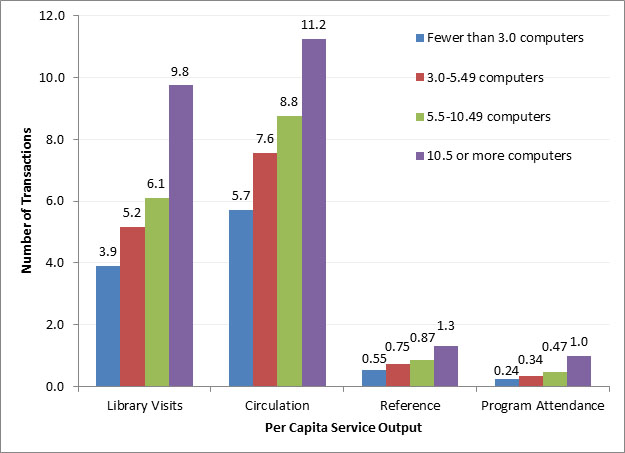Computer access is quickly becoming a staple service of public libraries in the United States. Between 2003 and 2007, the number of public-use Internet computers available in public libraries increased 33 percent. This may cause some to question if other, more traditional library services (such as circulation and reference), are falling by the wayside as public libraries focus on providing computer access.
This is not the case—according to national data from 2007, traditional services are not declining. Instead, as the number of public access computers per 5,000 of legal service area population rises, so do library visits, circulation, reference, and program attendance (see chart). This does not necessarily mean that traditional library services increase because access to public computers increases or vice versa, but it does indicate that libraries that have more public-use computers tend to have a higher frequency of traditional services as well.
Per Capita Service Outputs of U.S. Public Libraries by
Number of Public Library Computers per 5,000 Served, 2007

Note: U.S. libraries were divided evenly into 4 groups by the number of computers available per 5,000 served.
The data indicates that traditional services are not disappearing as libraries increase the availability of public access computers. However, it is not clear if traditional services drive the increase in available computers or if more computers attract patrons and in turn, traditional services thrive. Regardless, libraries are obviously not forced to choose between the two.
Correlations
The correlations between the number of computers and each service output discussed reveal that the relationship between them is significant. The two strongest relationships with the number of computers are with program attendance, with a correlation of 0.106, and library visits, with a correlation of 0.097 (see table). It should be mentioned that although all correlations were significant, the strength of the correlations were rather weak in 2007 and considerably lower than an analysis using 2003 data.[note]For more information on the previous analysis, see “Access to Internet Goes Hand in Hand with Other Public Library Services & May Attract Library Visitors”: http://www.lrs.org/documents/fastfacts/240_Output_By_Computers_REV.pdf.[/note] The decline in these correlations could be evidence that computer access in U.S. public libraries has become independent of these other services.
Correlation between Number of Computers and
Library Visits, Circulation, Reference, and Program Attendance
|
Number of Computers |
||
|
2003 |
2007 |
|
| Library Visits |
0.606 |
0.097 |
| Circulation |
0.299 |
0.064 |
| Reference |
0.292 |
0.048 |
| Program Attendance |
n/a[note]The relationship between program attendance and number of computers was not examined in the 2003 analysis.[/note] |
0.106 |
Conclusion
Clearly, increased computer access does not come at the cost of other library services. Providing computer access is no longer the “new kid on the block” and is, in fact, expanding to include Wi-Fi connectivity in most public libraries (76.4% nationally[note]Public Wireless Availability, 2004 –2009 from “Libraries Connect Communities 3: Public Library Funding & Technology Access Study 2007-2009.” http://www.ala.org/ala/research/initiatives/plftas/2008_2009/index.cfm.[/note]). Computer access should not be viewed as competing with other traditional library services any more than circulation competes with reference or programming. Instead, it seems, computer access has become one of the traditional services.
For more information about public libraries and technology, see the U.S. Public Libraries and the Use of Web Technologies Closer Look report at http://www.lrs.org/public/webtech.